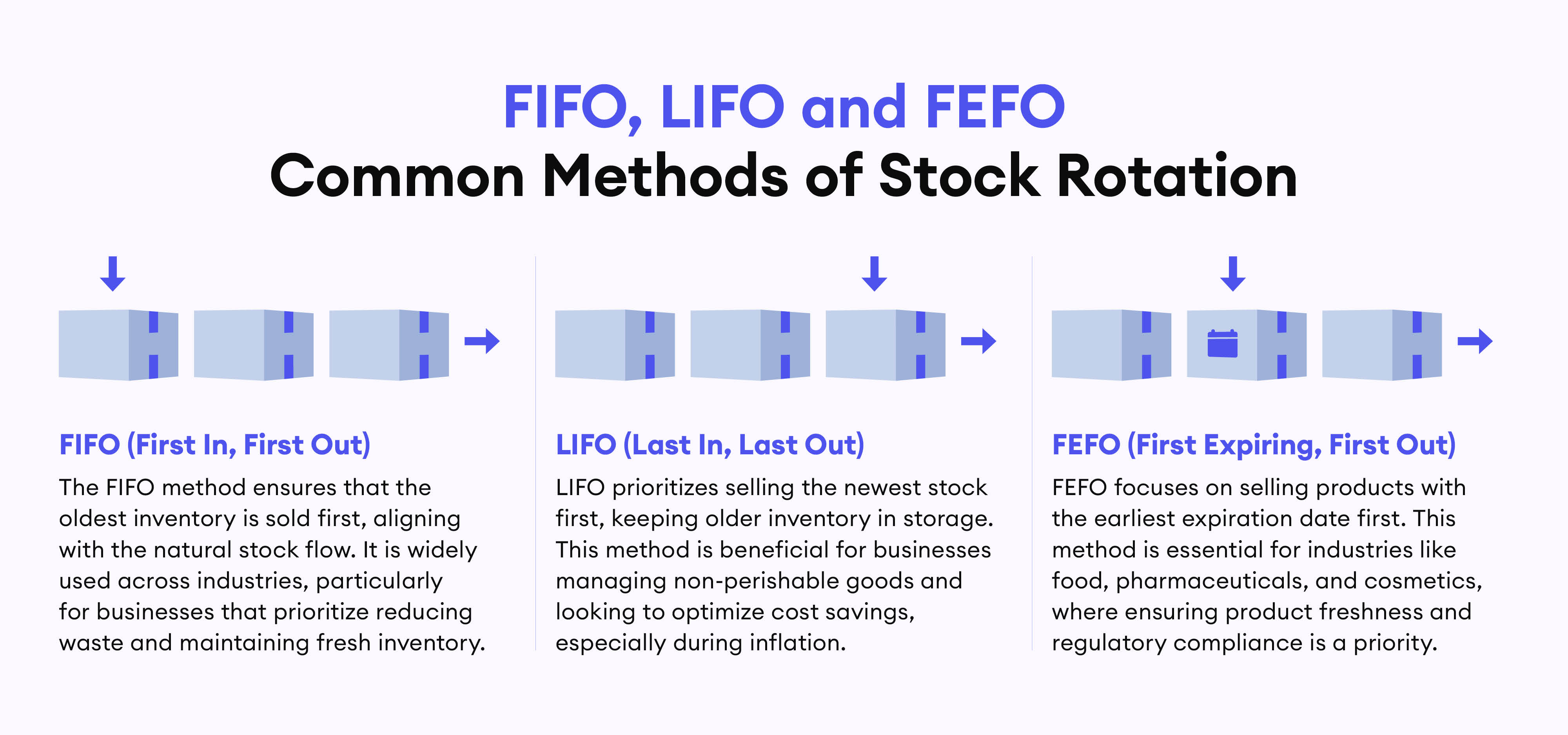Mastering Stock Rotation: A Guide to FIFO, LIFO and FEFO for Ecommerce Sellers

Did you know that $163 billion worth of expired or excess inventory is thrown away every year?¹
That’s more than the GDPs of Croatia, Costa Rica and Iceland - combined.
One of the biggest issues that results in wasted inventory is an ineffective stock rotation strategy. Does your business rotate stock effectively to reduce the risk of waste and make sure you’ve always got the right products available for your customers?
There are different ways of rotating stock and each one comes with it’s own pros and cons. It’s important to figure out the tactic that works best for you. In this blog post, we’ll take a closer look at the three most common methods of stock rotation: FIFO (First In, First Out), LIFO (Last In, Last Out) and FEFO (First Expiring, First Out). These strategies optimize stock management, reduce waste, avoid expired products and improve customer satisfaction.
After reading this post, you’ll know the pros and cons of each method and you’ll be fully informed to decide which is the best option for your business.
What is Stock Rotation and Why Does It Matter?
Stock rotation refers to how you organize your stock to prioritize the sale of certain products before others. If you purchase and sell products, you are rotating your inventory - it’s not really something you can avoid. Whether or not you do it in a strategic way is what makes the difference.
Paying attention to stock rotation forces you to closely monitor your inventory levels and movement through your warehouse, which helps you maintain optimal stock levels. The right method will keep older, slower-selling and perishable units of inventory from languishing on your shelves and expiring or going obsolete.
It’s also important to note that inventory rotation methods will also affect your current inventory value as an asset and will inform your Cost of Goods Sold for your Profit and Loss statement and your pricing.
This means that the ecommerce stock rotation method you choose will directly influence your profit margins, tax liabilities and the valuation of your inventory on the balance sheet.
Here’s an example:
Scenario: You purchase 100 units at $10 each, then later purchase another 100 units at $9 each. You sell 100 units. | ||
FIFO: Your Cost of Goods Sold is based on the $10 units, leaving the $9 units in inventory. | LIFO: Your Cost of Goods Sold is based on the $9 units, leaving the $10 units in inventory. | FEFO: The COGS will depend on the expiration dates of the products, regardless of the purchase price. |
Each method results in a different COGS for your P&L statement. | ||
 FIFO (First In, First Out)
FIFO (First In, First Out)
Definition
With the “First In, First Out” method, the oldest inventory item is the first to be sold. This method aligns with the natural flow of inventory and is widely used across various industries. It’s one of the best stock rotation methods for ecommerce businesses and it’s a great choice for businesses that are concerned with reducing inventory waste.
How it Works
FIFO is common in businesses that sell products with expiration dates, such as food stores and restaurants. It’s also an important practice in retail stores with short demand cycles, such as the technology industry, where older stock quickly becomes outdated or obsolete.
With the FIFO method, when new inventory is received it is placed at the back of the picking queue. The company organizes the inventory in the order they received it, and inventory that was received first will be picked first.
Goflow’s inventory management software uses FIFO to help Ecommerce sellers optimize their operations seamlessly.
Pros
Prevents spoilage and avoids items going obsolete before they can be sold.
It’s the most accurate way to reflect actual inventory flow for accounting purposes.
Often results in a higher inventory balance compared to other methods, which can strengthen your company’s balance sheet.
Cons
This method may require additional storage space for proper organization.
Stock rotation is a physical task and warehouse workers must take time and effort to move the older stock to the front of the shelves or closer to the fulfilment bay.
Although FIFO often results in higher net income and higher inventory balances, this also results in higher tax liabilities and potentially higher future write-offs, in the event that the inventory becomes obsolete.
Sometimes, FIFO doesn’t accurately reflect the true cost of materials if inventory has been stagnant while prices are rising.
LIFO (Last In, First Out)
Definition
While FIFO emphasizes selling the oldest stock first, LIFO (Last In, First Out) prioritizes selling the newest stock.
LIFO is ideal for businesses that handle non-perishable goods and want to maximize their operating capacity. However, it’s not realistic for many companies because it would mean their older inventory would sit idle in stock.
How it Works
For example, a warehouse storing construction materials might sell recent shipments of timber first, in order to keep up with fluctuating material costs.
This method is best for businesses that are managing non-perishable goods and want to prioritize cost-savings during inflation.
Pros
The LIFO method results in lower tax liability when prices are rising. Because you use recent inventory first, this reduces net income and gross profit, resulting in a reduced tax burden for the business.
With LIFO your recent costs are directly related to your current revenue, which means that if fulfillment costs have increased then you can adjust profit margins as necessary.
Using the LIFO method can save time when unloading and prevent physical damage and reduce security risks, because inventory is often more easily accessible because it has been recently purchased.
Cons
This method is not suitable for businesses selling products with expiration dates, such as pharmaceutical companies that risk compliance issues if older stock is left unused.
LIFO offers very little advantage in situations where prices are stable.
This method results in a lower net income compared to other methods.
Companies outside of the USA that must adhere to International Financial Reporting Standards (IFRS) are not permitted to use the LIFO method.
FEFO (First Expiring, First Out)
Definition
FEFO is the stock rotation method that prioritizes inventory with the earliest expiration date, ensuring the highest level of freshness. On average, businesses report that 4.3% of stock spoils in the supply chain before it even reaches the shelf.²
How it Works
For example, picture an online pharmacy selling vitamins. The products that are closest to their expiration date will be shipped first, which ensures customer safety and satisfaction.
This method is best for industries such as food, beverages or medical supplies, where expiration dates are critical. In fact, there may be many situations where this stock rotation strategy is required by law. For example, according to EU GDP-Guidelines, stock “should be rotated according to the “first expiry, first out” (FEFO) principle. Exceptions should be documented.”
Pros
Guarantees product freshness, ensuring that customers never receive items that are past their expiration date.
Reduces waste by prioritizing soon-to-expire items that otherwise may be thrown away.
Cons
This method requires precise tracking of expiration dates, which can be difficult to achieve.
Once the product goes past their expiration or removal date, there needs to be a removal strategy in place, which will add to the overall cost.
 Choose the Right Stock Rotation Method For Better Inventory Management
Choose the Right Stock Rotation Method For Better Inventory Management
Selecting a stock rotation strategy that aligns with the needs and goals of your business will solve a lot of problems. It will help you to improve the efficiency of your organization, as well as saving you money and increasing customer satisfaction. It’s worth taking the time to understand the inventory needs of your particular business, so you can determine which method will be the best fit.
Here at Goflow, we use FIFO as a stock rotation method, as it’s the best fit for the needs of our customer base. With Goflow’s smart, automated tools you can streamline stock rotation and optimize your business operations.
If that sounds like a good fit for your needs, why not schedule a demo and see how it can work for you?
Start today by scheduling a demo!
¹ $163 billion USD worth of inventory is discarded each year due to expiry or overproduction. The Missing Billions: The Real Cost of Supply Chain Waste, Avery Dennison, 2022 - https://rfid.averydennison.com/content/dam/rfid/en/news-and-insights/insights/white-papers/supply-chain-waste-report-the-missing-billions.pdf
² Supply chain crisis made worse as 8% of stock ends up as waste - Avery Dennison: https://rfid.averydennison.com/en/home/news-insights/press-releases/supply-chain-crisis-made-worse-as-8-percent-of-stock-ends-up-as-waste.html
